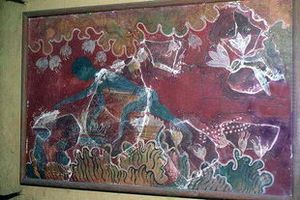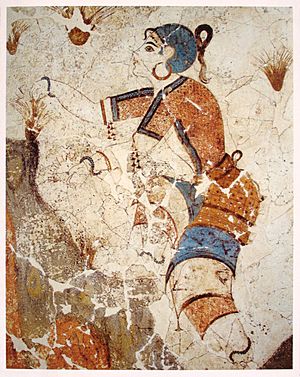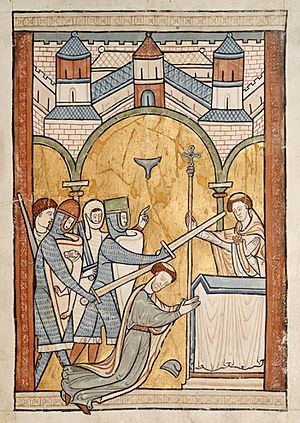History of saffron cultivation facts for kids
Saffron is a special spice that comes from a beautiful purple flower called the saffron crocus. People have been growing saffron for over 3,000 years! It all started when people in ancient Crete chose wild plants with long, colorful parts (called stigmas). Over time, they developed the saffron plant we know today.
The first time saffron was written about was around 700 BC in an old book from Assyria about plants. Since then, we've found that saffron was used to help treat many different health problems over the last 4,000 years.
Saffron in the Mediterranean

The ancient Minoans painted pictures of saffron in their palaces as far back as 1500–1600 BC. These pictures showed how saffron could be used as a medicine. Later, old Greek stories told of brave sailors traveling to Cilicia to find the world's most valuable saffron. Another legend says that a person named Crocus was turned into the first saffron flower!
People around the ancient Mediterranean Sea used saffron in many ways. Perfume makers in Egypt, doctors in Gaza, and people in Rhodes used it in perfumes, lotions, and even as makeup. They also used it in offerings to their gods and for medical treatments.
In ancient Egypt, Queen Cleopatra used saffron in her baths because it made her feel good. Egyptian healers also used saffron to treat many stomach problems. Saffron was even used to dye fabrics in cities like Sidon and Tyre. The Romans loved saffron so much that when they moved to southern Gaul (modern-day France), they brought their saffron plants with them and grew a lot of it.
Saffron in Asia
People were using paints made from saffron as far back as 50,000 years ago in the country we now call Iraq. Later, the Sumerians used wild saffron in their medicines and special magic drinks. Traders carried saffron over long distances even before 2000 BC.
Ancient Persians were growing their own type of saffron by 1000 BC. They sometimes wove saffron threads into cloth. They also gave saffron as gifts to their gods and used it in dyes, perfumes, medicines, and body washes. Saffron threads were even spread on beds and mixed into hot tea to help with sad feelings.
During his travels in Asia, Alexander the Great used Persian saffron in his tea, rice, and baths. He believed it helped heal his battle wounds. Alexander's soldiers copied him and brought the idea of saffron baths back to Greece.
No one is completely sure how saffron first arrived in South Asia. Some stories from Kashmir and China say it arrived between 900 and 2500 years ago. However, historians looking at old Persian records think it arrived before 500 BC. It might have been brought by Persians who planted saffron bulbs in new gardens, or during a Persian invasion of Kashmir.
Later, traders called Phoenicians sold Kashmiri saffron as a dye and a treatment for sadness. From there, saffron became popular in foods and dyes all over South Asia. For example, Buddhist monks in India started wearing saffron-colored robes after the Buddha died. But these robes were often dyed with less expensive plants like turmeric or jackfruit, not costly saffron.
Some historians think saffron came to China with Mongol invaders from Persia. However, saffron is mentioned in very old Chinese medical books from around 200–300 BC. These books list many plant-based medicines. Around 300 AD, Chinese experts were saying that saffron came from Kashmir. For example, a Chinese medical expert named Wan Zhen wrote that saffron grows in Kashmir and is mainly used as an offering to the Buddha. He also noted that saffron was valued for its bright yellow color and could be used to flavor wine.
Saffron in Europe
After the Roman Empire fell, growing saffron in Europe became much less common. Saffron was brought back when the Islamic civilization called "Al-Andalus" spread to Spain, France, and Italy.
During the terrible Black Death in the 1300s, people needed a lot of saffron for medicines. Much of it had to be brought by ships from places like Rhodes. Once, some noblemen stole a shipment of saffron, which started a fourteen-week-long "Saffron War"! This conflict made people afraid of saffron piracy, which led to more saffron being grown in places like Basel and Nuremberg.
Soon after, saffron growing spread throughout England, especially in areas like Norfolk and Suffolk. The town of Saffron Walden in Essex even got its name from this new special crop. It became England's main center for growing and trading saffron. However, new spices like chocolate, coffee, tea, and vanilla started arriving from other parts of the world. This caused the growing and use of saffron in Europe to decline. Only in southern France, Italy, and Spain did people continue to grow a lot of saffron.
Europeans also brought saffron to the Americas. Immigrants from the Schwenkfelder Church brought saffron bulbs with them when they left Europe. Many of these people had grown a lot of saffron in Europe. By 1730, the Pennsylvania Dutch people were growing saffron all over eastern Pennsylvania. Spanish colonies in the Caribbean bought large amounts of this new American saffron. Because of the high demand, saffron was sold for the same price as gold in Philadelphia!
However, the trade with the Caribbean stopped after the War of 1812, when many ships carrying saffron were destroyed. But the Pennsylvania Dutch continued to grow smaller amounts of saffron for local use. They used it in their cakes, noodles, and chicken or trout dishes. Growing saffron in America continued into modern times, mainly in Lancaster County, Pennsylvania.
|



